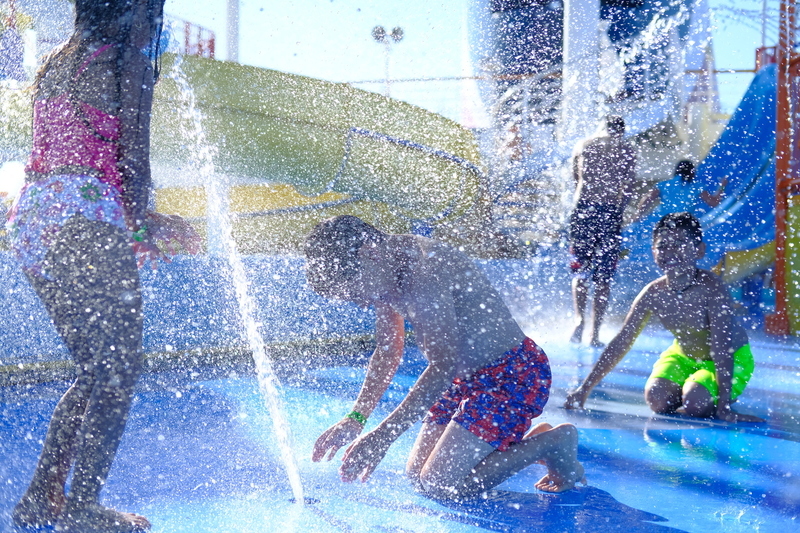There are many practical reasons to love spray parks. They’re less expensive to build and maintain than pools, they’re often free to the community, and they serve as a place to connect with neighbors and new families. Of course the main users of splash pads, kids, love them for a very obvious reason: they’re fun!
But how do you measure how fun a splash pad is?
Play Value
Fun is a hard thing to quantify and that’s why experts began using the term “play value.” Play Value quantifies how much play a user can experience with something be it a toy, a space, or a structure.
According to The Alliance for Early Childhood, something with high play value should appeal to kids of multiple ages and stages of development. It should allow for multiple kinds of play, for kids to learn a respectful way to interact, and it should stand the test of time.
Building blocks and dolls, for example, are considered toys with high play value because there are many ways to engage with them; there are always new things to build and new stories to tell. Something with low play value might have a lot of novelty and interest at first, but the design often limits how much kids can actually do. Fad toys (remember Pogs?) come and go because, from a play-based level, there is less to do with them.
So, when thinking about play value, a well balanced community has many outdoor spaces to foster play. There will be playgrounds, open green spaces, sports fields, and pools, which have all stood the test of time in terms of being a staple in many childhoods. They have adapted in response to evolving safety information, changing community needs, and shifting attention. They allow for many types of play, and appeal to multiple stages of development. Kids can learn to co-play, share, and take turns in all of these spaces.
Splash pads are newer to the playing field, but making up for it with staggering adoption rates. They’re most often compared to things that already exist, such as wet playgrounds, or maybe zero-depth pools. While they share similarities with playgrounds and pools, splash pads have opportunities for play that kids just don’t see anywhere else.
What Kind of Play Value Does a Splash Pad Have?
An example of free and unregulated play
There are not many objective, peer-reviewed studies about splash pads. One of the most comprehensive studies we’ve found is Lisa J Lewis’s 2005 paper “Role of Splash Parks in Outdoor Public Recreation” wherein she speaks to industry professionals, digs into play research, and finishes with an observational study of local splash pads.
Lewis notes that “not only do splash parks provide a more versatile play value than swimming pools, some of the risks are simply avoided.” (pg. 9) Since splash pads don’t have standing water, the chance for accidental drowning or entrapment is eliminated. Like playgrounds, splash pad manufacturers have created many different kinds of features and experiences to appeal to different age groups. Toddlers can interact with inset jets, while older kids can use water guns and run through sprayers. It’s a transitional step for kids to become comfortable and excited about water before swimming lessons, without throwing them right into the deep end.
After observing children at two different splash pads, Lewis concluded that, “splash parks provide the opportunity for water play with children defining the activity level. Because of the free play and the interaction of a variety of ages and ability, it is developmentally beneficial.” (pg 90)
Why Does It Matter?
We know kids need to play. According to Kenneth R. Ginsburg and the Committee on Communications, and the Committee on Psychosocial Aspects of Child and Family Health: ”Play is essential to development because it contributes to the cognitive, physical, social, and emotional well-being of children and youth” (x)
On top of the psychological reasons for play, there are the health benefits of active playing. Children, U.S. Authorities say, should be getting at least 60 minutes of active time per day, and 2/3rds of them simply are not (x). In the summer when temperatures soar, it can be difficult to get kids excited to go to the park. This is why splash pads make so much sense as an added feature to parks to increase active play in communities. Splash pads are a place for kids, especially younger kids, to play joyfully and freely, as well as cool off. With a splash pad kids have a much better chance to be active by the nature of a flat surface without standing water. In addition, the features encourage kids to run through, crawl around, and hop over them.
In her final conclusions, Lewis states, “Another factor which affected the pace of the play was the surface material. In Waco, the children ran, skipped and jumped… Indeed, these activities were discouraged by the lifeguard, justifiably, for safety reasons. There is absolutely no doubt that a cushioned surface enhanced the play value, while a broom-finished concrete surface inhibits many behaviors and reduced the play value.” (pg 77)
Join us in a few weeks as we explore the topic of safety surfacing and play value more.


